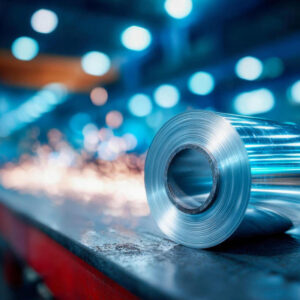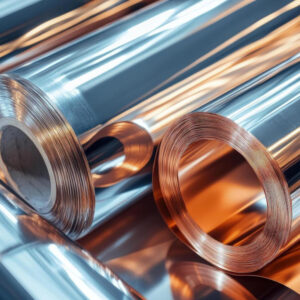Iron-Chromium-Aluminum (FeCrAl) series
Discover the Advantages of the FeCrAl Alloy
The FeCrAl alloy offers outstanding properties that make it the perfect choice for demanding applications. With its high specific resistivity and a low temperature resistance coefficient, it not only ensures excellent conductivity but also provides effective protection against oxidation and corrosion — even at extremely high temperatures.
Applications:
- Industrial furnaces: For efficient heat generation
- Household appliances: Reliable heating elements for everyday use
- Metallurgy and machinery: Essential for precise processes
- Aerospace and automotive: Meeting high performance demands
- Military and specialty industries: Durability and resistance where it matters
Rely on the FeCrAl alloy for your heating and resistance elements. Choose quality and performance that deliver across industries.
Size range (mm): (0,05-0,35) × (0,5-6,0)
Variants: 1Cr13Al4, 0Cr15Al5, 0Cr19Al3, 0Cr21Al6, 0Cr23Al5, 0Cr25Al5, 0Cr21Al6Nb, 0Cr27Al7Mo2
| Alloy Nomenclature Performance |
1Cr13Al4 | 0Cr25AI5 | 0Cr21Al6 | 0Cr23Al5 | 0Cr21Al4 | 0Cr21AI6Nb | 0Cr27Al7Mo2 | |
|---|---|---|---|---|---|---|---|---|
| Chemical Composition (%) |
Cr | 12.0-15.0 | 23.0-26.0 | 19.0-22.0 | 20.5-23.5 | 18.0-21.0 | 21.0-23.0 | 26.5-27.8 |
| Al | 4.0-6.0 | 4.5-6.5 | 5.0-7.0 | 4.2-5.3 | 3.0-4.2 | 5.0-7.0 | 6.0-7.0 | |
| Re | opportune | opportune | opportune | opportune | opportune | opportune | opportune | |
| Fe | REST | REST | REST | REST | REST | REST | REST | |
| — | — | — | — | — | Nb0.5 | Mo1.8-2.2 | ||
| Max. continuous service temp. of element (°C) |
950 | 1250 | 1250 | 1250 | 1100 | 1350 | 1400 | |
| Resistivity at 20°C (μΩ⋅m) |
1.25 | 1.42 | 1.42 | 1.35 | 1.23 | 1.45 | 1.53 | |
| Density (g/cm³) | 7.4 | 7.1 | 7.16 | 7.25 | 7.35 | 7.1 | 7.1 | |
| Thermal conductivity (KJ/m⋅h⋅°C) |
52.7 | 46.1 | 63.2 | 60.2 | 46.9 | 46.1 | — | |
| Coefficient of lines expansion (α×10⁻⁶ / °C) |
15.4 | 16 | 14.7 | 15 | 13.5 | 16 | 16 | |
| Melting point approx. (°C) | 1450 | 1500 | 1500 | 1500 | 1500 | 1510 | 1520 | |
| Tensile strength (N/mm²) | 580-680 | 630-780 | 630-780 | 630-780 | 600-700 | 650-800 | 680-830 | |
| Elongation at rupture (%) | >16 | >12 | >12 | >12 | >12 | >12 | >10 | |
| Variation of area (%) | 65-75 | 65-75 | 65-75 | 65-75 | 65-75 | 65-75 | 65-75 | |
| Repeat Bending frequency (F/R) |
>5 | >5 | >5 | >5 | >5 | >5 | >5 | |
| Hardness (H.B.) | 200-260 | 200-260 | 200-260 | 200-260 | 200-260 | 200-260 | 200-260 | |
| Continuous servicetime (Hours/°C) |
— | >80/1300 | >80/1300 | >80/1300 | >80/1250 | >50/1350 | >50/1350 | |
| Micrographic structure | Ferrite | Ferrite | Ferrite | Ferrite | Ferrite | Ferrite | Ferrite | |
| Magnetic properties | Magnetic | Magnetic | Magnetic | Magnetic | Magnetic | Magnetic | Magnetic | |
Nickel-Chromium (NiCr) series
Nichrome — The Ideal Choice for High-Temperature Applications
Nichrome stands out as a premium material thanks to excellent ductility, workability, and weldability even at high temperatures and under dynamic loading. The nickel‑chromium alloy also offers:
- High and stable resistance for precise performance
- Corrosion and surface oxidation resistance for long service life
- Excellent coil-forming ability, ideal for heating elements and coils
Perfect for industrial heating elements, electrical resistors, and demanding applications where reliability and formability are crucial. Choose Nichrome for durable, high-performance solutions.
Size range (mm): (0,05-0,35) × (0,5-6,0)
Variants: Cr10Ni90, Cr20Ni80, Cr15Ni60, Cr20Ni35, Cr20Ni30, Cr30Ni70
| Performance/ material | Cr10Ni90 | Cr20Ni80 | Cr30Ni70 | Cr15Ni60 | Cr20Ni35 | Cr20Ni30 | |
|---|---|---|---|---|---|---|---|
| Chemical Composition (%) |
Ni | 09 | Rest | Rest | 55.0~61.0 | 34.0~37.0 | 30.0~34.0 |
| Cr | 10 | 20.0~23.0 | 28.0~31.0 | 15.0~18.0 | 18.0~21.0 | 18.0~21.0 | |
| Fe | — | ≤1.0 | ≤1.0 | REST | REST | REST | |
| Maximum temperature (°C) | 1300 | 1200 | 1250 | 1150 | 1100 | 1100 | |
| Melting point (°C) | 1400 | 1400 | 1380 | 1390 | 1390 | 1390 | |
| Density (g/cm³) | 8.7 | 8.4 | 8.1 | 8.2 | 7.9 | 7.9 | |
| Resistivity (μΩ⋅m, 20°C) | — | 1.09±0.05 | 1.18±0.05 | 1.12±0.05 | 1.00±0.05 | 1.04±0.05 | |
| Elongation at rupture | ≥20 | ≥20 | ≥20 | ≥20 | ≥20 | ≥20 | |
| Specific heat (J/g.°C) | — | 0.44 | 0.461 | 0.494 | 0.5 | 0.5 | |
| Thermal conductivity (KJ/m.h°C) |
— | 60.3 | 45.2 | 45.2 | 43.8 | 43.8 | |
| Coefficient of lines expansion (α×10⁻⁶ / (20~1000°C)) |
— | 18 | 17 | 17 | 19 | 19 | |
| Micrographic structure | — | Austenite | Austenite | Austenite | Austenite | Austenite | |
| Magnetic properties | — | Nonmagnetic | Nonmagnetic | Nonmagnetic | Weak magnetic | Weak magnetic | |
Copper-nickel (CuNi) series
Copper‑Nickel Alloy — Reliable, Powerful, Malleable
The copper‑nickel alloy impresses with low electrical resistance, high heat and corrosion resistance, and very good processability and solderability. This makes it ideal for demanding electrical components.
Applications:
- Switching and protection technology: Key components in thermal overload relays and low-resistance thermal circuit breakers
- Electrical appliances: Reliable contact and conductor solutions
- Electric heating cables: Robust material for heating elements and flexible conductors
Choose copper‑nickel for durable, precise, and high-performing electrical components.
Size range (mm): (0,05-0,35) × (0,5-6,0)
Variants: CuNi1, CuNi2, CuNi6, CuNi8, CuNi10, CuNi14, CuNi19, CuNi23, CuNi30, CuNi34, CuNi40, CuNi44, 6J8, 6J11, 6J12, 6J13
| Performance | Constantan 6J40 |
New Constantan 6J11 |
Manganin 6J12 |
Manganin 6J8 |
Manganin 6J13 |
|
|---|---|---|---|---|---|---|
| Chemical Composition (%) |
Ni | 1~2 | 10.5~12.5 | 11~13 | 8~10 | 11~13 |
| Cr | 39~41 | — | 2~3 | — | 2~5 | |
| Fe | REST | REST | REST | REST | REST | |
| — | Al2.5~4.5 Fe1.0~1.6 | — | Si1~2 | — | ||
| Temperature Range for Components (°C) |
5~500 | 5~500 | 5~45 | 10~80 | 10~80 | |
| Density (g/cm³) | 8.88 | 8 | 8.44 | 8.7 | 8.4 | |
| Resistivity (μΩ⋅m,20) | 0.48±0.03 | 0.49±0.03 | 0.47±0.03 | 0.35±0.05 | 0.44±0.04 | |
| Extensibility (%⌀0.5) | ≥15 | ≥15 | ≥15 | ≥15 | ≥15 | |
| Resistance Temperature Quotiety (α×10-6 / °C) |
-40~+40 | -80~+80 | -3~+20 | -5~+10 | 0~+40 | |
| Thermoelectromotive force to Copper (μV / (0~100)) |
45 | 2 | 1 | 2 | 2 | |
| Properties/ Material |
Resistivity (200°C μΩ⋅m) |
Max. working temperature (°C) |
Tensile strength (Mpa) |
Melting point (°C) |
Density (g/cm³) |
TCR (×10⁻⁶ / °C) (20~600°C) |
EMF vs Cu (μV / °C) (0~100°C) |
|---|---|---|---|---|---|---|---|
| NC003 (CuNi1) |
0.03 | 200 | 210 | 1085 | 8.9 | <100 | -8 |
| NC005 (CuNi2) |
0.05 | 200 | 220 | 1090 | 8.9 | <120 | -12 |
| NC010 (CuNi6) |
0.1 | 220 | 250 | 1095 | 8.9 | <60 | -18 |
| NC012 (CuNi8) |
0.12 | 250 | 270 | 1097 | 8.9 | <57 | -22 |
| NC015 (CuNi10) |
0.15 | 250 | 290 | 110 | 8.9 | <50 | -25 |
| NC020 (CuNi14) |
0.2 | 300 | 310 | 1115 | 8.9 | <30 | -28 |
| NC025 (CuNi19) |
0.25 | 300 | 350 | 1150 | 8.9 | <25 | -32 |
| NC030 (CuNi23) |
0.3 | 300 | 350 | 1150 | 8.9 | <16 | -34 |
| NC035 (CuNi30) |
0.35 | 350 | 400 | 1170 | 8.9 | <10 | -37 |
| NC040 (CuNi34) |
0.4 | 350 | 400 | 1180 | 8.9 | 0 | -39 |
| NC050 (CuNi44) |
0.5 | 400 | 420 | 1200 | 8.9 | <-6 | -43 |
Pure Nickel (Ni) Series
Pure Nickel — Robust, Corrosion-Resistant, and Heat-Resistant
Pure nickel is characterized by high mechanical strength, excellent corrosion resistance, and outstanding heat resistance. These properties make it the first choice for demanding technical applications.
Application Areas:
- Electrical equipment: Contacts, terminals, and components with high load capacity
- Chemical process engineering: Durable components for corrosive environments
- Processing and manufacturing machinery: Long-lasting, high-performance parts
- Rechargeable batteries, computers & mobile phones: Reliable materials for modern electronics
- Power tools and camcorders: Robustness and stability under heavy use
Opt for pure nickel for durable, high-performance solutions in industry and electronics.
Size range (mm): (0,05-0,2) × (0,5-6,0)
Variants: N4, N6, Ni200, Ni201
| Grade | N4 | N6 | Nickel 201 | Nickel 200 | |
|---|---|---|---|---|---|
| Chemical Composition (%) |
Ni | — | — | ≥ 99 | ≥ 99.2 |
| Ni+Co | 99.9 | 99.5 | — | — | |
| Cu | ≤0.015 | 0.1 | ≤0.25 | ≤0.25 | |
| Si | ≤0.03 | 0.1 | ≤0.35 | ≤0.35 | |
| Mn | ≤0.002 | 0.05 | ≤0.35 | ≤0.35 | |
| C | ≤0.01 | 0.1 | ≤0.02 | ≤0.15 | |
| Mg | ≤0.01 | 0.1 | — | — | |
| S | ≤0.001 | 0.005 | ≤0.01 | ≤0.01 | |
| P | ≤0.001 | 0.002 | — | — | |
| Fe | ≤0.004 | 0.1 | ≤0.04 | ≤0.04 | |



